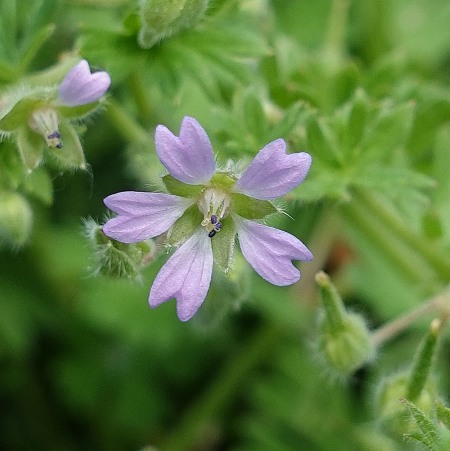Description: This herbaceous plant is a summer annual that produces sprawling to weakly ascending stems up to 20" long. The stems are light green to reddish green, terete, and short-pubescent, branching occasionally. Initially, basal leaves are produced, but shortly thereafter opposite leaves occur at intervals along these stems, although the upper (outer) leaves are sometimes alternate. The leaf blades are typically ¾-1½" across with an orbicular to orbicular-reniform outline; they are palmately and sharply cleft into 3-9 primary lobes, and each of these lobes are further subdivided into 3 tooth-like secondary lobes. The primary lobes extend to about one-half of the distance of the leaf blades; their margins are slightly ciliate. The upper leaf blade surface is light-medium to medium green and hairless (or nearly so), while the lower blade surface is light green and hairy along the veins and short-pubescent between the veins. The petioles of the leaves are about the same length as their blades initially, but they later become shorter than their blades and eventually nearly sessile where the axillary inflorescences occur. These petioles are are similar to the stems, but they are more narrow. At the base of each petiole, there is a pair of short linear stipules that are insignificant.


Cultivation: The preference is full sun or partial sun, moist to dry-mesic conditions, and soil containing loam, clay-loam, or gravelly loam. Because of its small size, this plant can spread somewhat aggressively on lawns that are occasionally or infrequently mowed.
Range & Habitat: Small Geranium is an uncommon weedy plant in Illinois (see Distribution Map). However, it may be more common than official records indicate. It was accidentally introduced from Eurasia. Habitats in grassy roadsides, grassy areas and waste areas along railroads, grassy pathways, small weedy meadows, lawns, sunny riverbanks, vacant lots, and other waste areas. Habitats with a history of disturbance are definitely preferred. Lawn mowers probably assist in the spread of this plant.

Faunal Associations: Floral-faunal information for this obscure non-native plant is very limited. Probably short-tongued bees, flies, wasps, and beetles visit the flowers for nectar or pollen. Insects that feed destructively on geranium species (Geranium spp.) include Acyrthosiphon malvae (Geranium Aphid), polyphagous Aulacorthum solani (Foxglove Aphid), and the polyphagous larvae of a Tortricid moth, Archips purpurana (Omnivorous Leafroller Moth); see Blackman & Eastop (accessed 2013), Pepper (1965), and Covell (1984/2005). The Mourning Dove, a ground-feeding bird that eats seeds, has been observed to feed on the seeds of a similar plant, Geranium carolinianum (Carolina Geranium), so it seems likely it would feed on the seeds of this plant (Lewis, 1993; Martin et al., 1951/1961).
Photographic Location: A small colony of plants was found in a waste area along a railroad in Urbana, Illinois.

Comments: There are several Geranium spp. that have been introduced, either accidentally or deliberately, to North America from Eurasia. Most of these are short-lived plants that have small flowers and palmately lobed leaves, although one or two, have been used to create hybrid ornamental plants with larger flowers. The non-native Small Cranesbill resembles the native Carolina Cranesbill (Geranium carolinianum) and they occupy similar habitats, so it is possible to confuse these two species. Their differences are the following: 1) the leaves of Small Cranesbill are somewhat smaller in size, but they are less deeply lobed, 2) the flowers of Small Cranesbill are more pink or lavender and they are slightly smaller in size, and 3) the sepals of Small Cranesbill's flowers don't taper to solitary short bristles, instead they have acute tips without bristles. Small Cranesbill also differs from many Geranium spp. by having flowers with 5 stamens with purplish anthers (and 5 smaller staminodes), instead of 10 stamens with white or yellow anthers. The cultivated Geranium that most people are familiar with in horticulture is not a Geranium species (although it is in the Geranium family), instead it is a Pelargonium species and it's from South Africa.